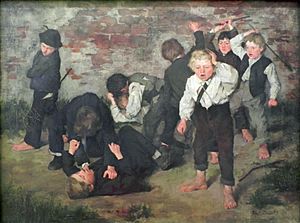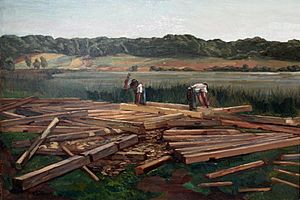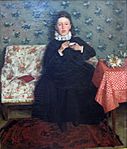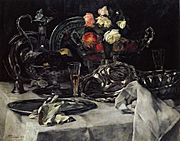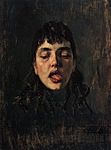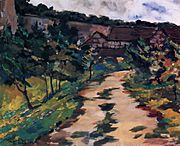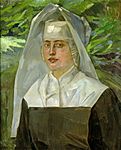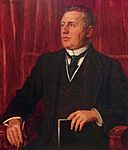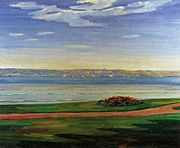Wilhelm Trübner facts for kids
Quick facts for kids
Wilhelm Trübner
|
|
|---|---|
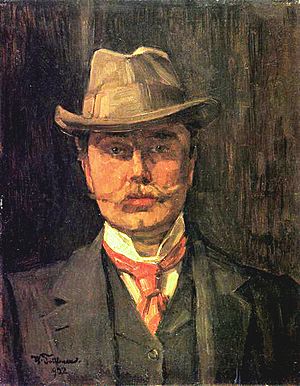
Self portrait (1902)
|
|
| Born | February 3, 1851 |
| Died | December 21, 1917 (aged 66) |
| Nationality | German |
| Known for | Painting |
| Movement | Realism |
| Spouse(s) | Alice Trübner née Auerbach |
Wilhelm Trübner (born February 3, 1851 – died December 21, 1917) was a German painter. He was known for his realistic style. Trübner was part of a group of artists who admired the work of Wilhelm Leibl.
Contents
Wilhelm Trübner: A German Painter
Early Life and Art Training
Wilhelm Trübner was born in Heidelberg, Germany. He was the third son in his family. His father, Johann Georg Trübner, was a silver and goldsmith.
In 1867, Wilhelm began training to be a goldsmith. During this time, he met a painter named Anselm Feuerbach. Feuerbach saw Trübner's talent and encouraged him to study painting instead.
That same year, Trübner started art school in Karlsruhe. He learned from Karl Friedrich Schick. He also met other artists there, like Hans Canon and Feodor Dietz, who influenced his early work.
Discovering New Art Styles
In 1869, Trübner moved to Munich to study at the Kunstacademie. There, he saw an important art show. It featured paintings by Wilhelm Leibl and Gustave Courbet. Courbet's art really impressed him.
Courbet visited Munich in 1869. He not only showed his paintings but also demonstrated his painting method. He worked quickly from real life, a technique called alla prima. This was a fresh and exciting way to paint. Many young artists in Munich found Courbet's style much better than the old, strict rules of traditional art schools.
The "Leibl Circle"
In 1870, Trübner became friends with Carl Schuch and Albert Lang. In 1871, these three artists went on hikes together. They painted landscapes in places like Hohenschwangau and Bernried. During these trips, they met Wilhelm Leibl.
In 1872, Trübner also met Hans Thoma, another German painter. Thoma also admired Leibl's realistic style. Trübner, Schuch, Lang, and Thoma became the main members of a group called the "Leibl circle." They all shared a similar approach to art.
Travels and Artistic Peak
The early 1870s were a time of great discovery for Trübner. He traveled to Italy, Holland, and Belgium. In Paris, he saw the art of Édouard Manet. Manet's style influenced Trübner's portraits and landscapes. His paintings became more spontaneous but still controlled.
Art expert Eberhard Ruhmer said that Trübner's best work was between 1872 and 1876. During this time, he created some of the most important paintings for the Leibl circle. He made what he called "purist painting." This meant that the way a painting was made (its colors, shapes) was more important than what it showed.
His paintings from this time, like On the Sofa (1872) and Carpenters on the Banks of Wessling Lake (1876), show everyday scenes. They have a serious, realistic feel and calm colors. Later, Trübner tried to make his paintings brighter. He also started painting more historical and literary subjects.
Art Theory and Teaching
Wilhelm Trübner also wrote about art. In 1892 and 1898, he published his ideas. He believed that "beauty must lie in the painting itself, not in the subject." This means that the beauty of a painting comes from its colors, proportions, and how it's painted. It's not just about what the painting shows. This idea is often called "art for art's sake."
In 1901, he joined the Berlin Secession. This was an important group in Germany for showing new and modern art. From 1903 until his death in 1917, Trübner was a professor at the Academy of Arts in Karlsruhe. He was also the director of the academy from 1904 to 1910.
Trübner's paintings are now in many public art collections. You can find them in Germany, like at the Alte Nationalgalerie in Berlin. They are also in Vienna, Austria, at the Österreichische Galerie Belvedere, and in Munich, Germany, at the Neue Pinakothek.
Gallery
-
The Death of Pope Alexander VI (1883)
-
Ermatingen am Bodensee (1894), gouache on paper
See also
 In Spanish: Wilhelm Trübner para niños
In Spanish: Wilhelm Trübner para niños


